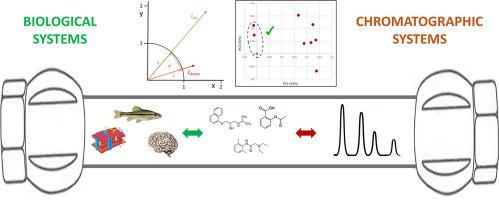生物过程的色谱代用建模教程
IF 3.2
引用次数: 0
摘要
在药理学、毒理学和环境科学中,通过理化模型准确模拟生物分区系统对于了解物质的 ADMET 特征至关重要。直接在生物系统中进行实验耗时长、成本高,而且在伦理和实践方面都具有挑战性,因此开发可靠的理化模型至关重要。这些模型有助于预测化合物在生物体内的行为,减少动物试验,简化药物发现和风险评估。色谱系统具有多功能性,只需改变流动相和固定相或伪固定相的性质,就能提供大量不同的分区系统,因此在模拟生物或环境过程方面具有特别的意义。理化系统在模拟生物过程中的有效性通常是通过与生物数据的经验相关性来评估的。然而,使用共同的模型(如亚伯拉罕溶解模型)对物理化学和生物系统进行表征,只需比较模型的系统常数,就能确定替代特定生物或环境过程的最佳物理化学系统。本教程演示了如何比较、预测和提高理化系统替代生物或环境系统的效率,而无需先前的经验相关性。以皮肤渗透为例,介绍色谱代用和案例研究。本文章由计算机程序翻译,如有差异,请以英文原文为准。

Tutorial on modelling chromatographic surrogation of biological processes
The accurate emulation of biological partition systems through physicochemical models is crucial in pharmacology, toxicology, and environmental science for understanding the ADMET profiles of substances. Direct experimentation on biological systems can be long, expensive, and ethically and practically challenging, so developing reliable physicochemical models is essential. These models help predict compound behaviour in organisms, reduce animal testing, and streamline drug discovery and risk assessment. Chromatographic systems are of particular interest to mimic biological or environmental processes because of its versatility, as they provide a large number of different partition systems only by changing the nature of the mobile and stationary or pseudostationary phases. The effectiveness of any physicochemical system in emulating biological processes is usually evaluated through empirical correlation with biological data. However, the characterization of physicochemical and biological systems using a common model, such as Abraham's solvation model, allows to identify the best physicochemical systems to surrogate particular biological or environmental processes, only by comparison of the system constants of the models. This tutorial demonstrates how to compare, predict, and improve the efficiency of physicochemical systems to surrogate biological or environmental ones without the need for previous empirical correlations. Skin permeation is presented as example of chromatographic surrogation and case study.
求助全文
通过发布文献求助,成功后即可免费获取论文全文。
去求助
来源期刊

Journal of chromatography open
Analytical Chemistry
CiteScore
2.50
自引率
0.00%
发文量
0
审稿时长
50 days
 求助内容:
求助内容: 应助结果提醒方式:
应助结果提醒方式:


